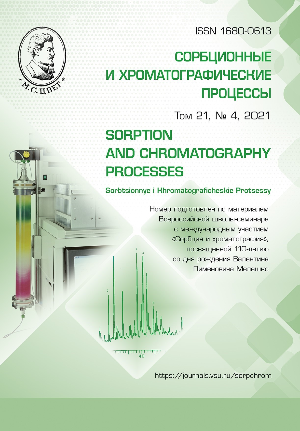Isolation and identificationof succinate dehydrogenase genes by membrane methods
Abstract
The most important stage in the preparation of biological samples for biochemical and/or diagnostic processes is the isolation of nucleic acids from the sample. The choice of the method for RNA isolation depends, first of all, on the set tasks and a number of requirements. Among the key requirements are: the cost-effectiveness and simplicity of the method, a high yield of the isolated RNA, and a sufficient degree of purification of the final product. The purpose of this work was to identify succinate dehydrogenase genes in the cells of rat liver using a silica gel membrane to isolate total cellular RNA. The PureLink®RNA MiniKit (Invitrogen, USA) made it possible to obtain a preparation of total RNA practically with no traces of degradation, which was confirmed by the content of 28S pRNA that was approximately three times higher than the content of 18S pRNA. The PureLink® technology provided a high RNA yield. Another important advantage of the method was that it did not require extraction with toxic solvents (phenol/chloroform), centrifugation with CsCl or LiCl, or precipitation with alcohol, i.e. the use of substances that are PCR inhibitors. In addition, due to a rare change of tips and eppendorves, the possibility of contamination was significantly reduced, which was confirmed spectrophotometrically (the A260/A280 ratio for the isolated RNA preparation was 2.03, and the A260/A230 ratio was 1.98, which characterises the preparation as highly purified). Thus, an effective method was selected for the isolation of total cellular RNA without the impurities of extraneous nucleic acids. The pure RNA obtained as a result of isolation using a silica gel membrane was further used to obtain a complementary DNA. The cDNA obtained by the reverse transcription reaction method was subsequently used for a quantitative assessment of the content of gene transcripts encoding subunits A and B (sdha and sdhb) of succinate dehydrogenase. Further PCR analysis showed that the selected primers are specific and can be used in further studies to determine the transcription rate for the sdha and sdhb genes of succinate dehydrogenase in normal rats and in rats with various pathologies.
Downloads
References
Harwood A.J., Methods in Molecular Biology, 1994, Vol. 58, pp. 3-7.
Grigor'eva E.A., Nejolova O.V., Sovremennye naukoemkie tehnologii, 2014, No 7-2. p. 85.
Krisilova E.V., Oros G.Yu., Krisilov A.V., Selemenev V.F., Zhurnal fizicheskoj khimii, 2014, Vol. 88, No 4, pp. 692-696.
Moss D., Harbison S.A., Saul D.J., Int. J. LegalMed., 2003, Vol. 117, pp. 340-349.
Buckingham L., Flaws M.L. Molecular Diagnostics: Fundamentals, Methods, &Clinical Applications, F.A. Davis, Phila-delphia, Pa, USA, 2007, 479 p.
Cseke L.J., Kaufman Р.В., Podila G.K., Tsai С.-J. Hand book of Molecular and Cel-lular Methods in Biology and Medicine – CRCPress, BocaRaton, Fla, USA, 2ndedition, 2004, 580 p.
Boom R., Sol C.J., Salimans M.M., Jan-sen C.L. et al., J. Clin. Microbiol., 1990, Vol. 28, No 3, pp. 495-503.
Eprincev A.T., Popov V.N., Shevchenko M.Yu. Jekspressija i reguljacija fermentov glioksilatnogo cikla, Voronezh, Central'no-Chernozemnoe knizhnoe izd-vo, 2005, 224 p.
Vu T.L., Selivanova N.V., Eprincev A.T., Fedorin D.N., Sorbtsionnye I khroma-tograficheskie protsessy, 2011, Vol. 11, No 6, pp. 900-904.
Eprincev A.T., Fedorin D.N., Selivanova N.V. Molekuljarnye aspekty formirovani-ja oligomernoj struktury sukcinatdegidro-genazy, Voronezh, 2016, 264 p.
Bustin S.A., J MolEndocrinol, 2002, pp. 23-39. doi: 10.1677/jme.0.0290023.
Selemenev V.F. Pigmenty pishchevyh proizvodstv (melanoidiny), M., DeLi print, 2008. 245 p.
Chen Q., Yu H.W., Wang X.R., Xie X.L. et al., Genet. Mol. Res., 2012, Vol. 11, No 2, pp. 1773-1782.doi: 10.4238/2012.
Saiki R.K., Gelfand D.H., Stoffel S., Scharf S.J. et al., Science, 1988, Vol. 239, No 4839, pp.487-91







